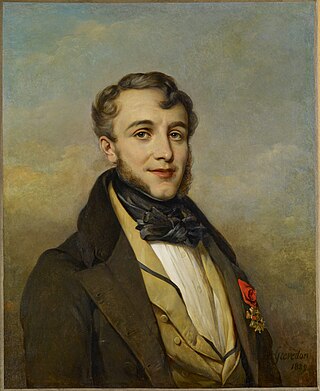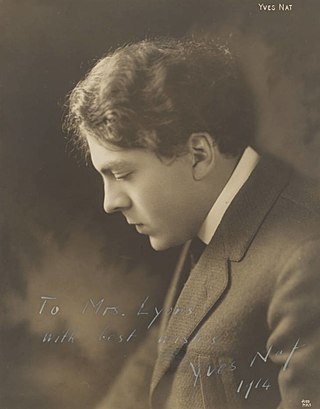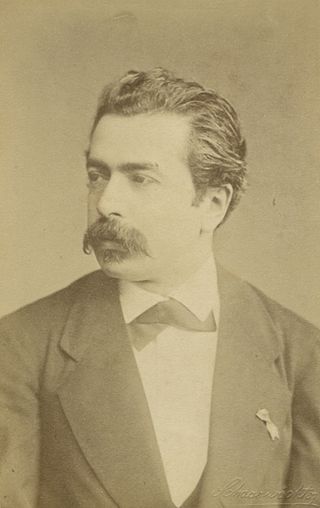
Charles-Camille Saint-Saëns was a French composer, organist, conductor and pianist of the Romantic era. His best-known works include Introduction and Rondo Capriccioso (1863), the Second Piano Concerto (1868), the First Cello Concerto (1872), Danse macabre (1874), the opera Samson and Delilah (1877), the Third Violin Concerto (1880), the Third ("Organ") Symphony (1886) and The Carnival of the Animals (1886).

Marcel Jean-Jules Dupré was a French organist, composer, and pedagogue.

The Conservatoire de Paris, also known as the Paris Conservatory, is a college of music and dance founded in 1795. Officially known as the Conservatoire National Supérieur de Musique et de Danse de Paris, it is situated in the avenue Jean Jaurès in the 19th arrondissement of Paris, France. The Conservatoire offers instruction in music and dance, drawing on the traditions of the 'French School'.

Friedrich Wilhelm Michael Kalkbrenner, also known as Frédéric Kalkbrenner, was a pianist, composer, piano teacher and piano manufacturer. German by birth, Kalkbrenner studied at the Conservatoire de Paris, starting at a young age and eventually settled in Paris, where he lived until his death in 1849. Kalkbrenner composed more than 200 piano works, as well as many piano concertos and operas.

Lazare Lévy, also hyphenated as Lazare-Lévy, was an influential French pianist, organist, composer and pedagogue. As a virtuoso pianist he toured throughout Europe, in North Africa, Israel, the Soviet Union and Japan. He taught for many years at the Paris Conservatoire.

Marguerite Marie-Charlotte Long was a French pianist, pedagogue, lecturer, and an ambassador of French music.

Antoine François Marmontel was a French pianist, composer, teacher and musicographer. He is mainly known today as an influential teacher at the Paris Conservatory, where he taught many musicians who became leading voices of French music in the late 19th and early 20th century.

Yves Philippe Avit Nat was a French pianist and composer.

Camille-Marie Stamaty was a French pianist, piano teacher and composer predominantly of piano music and studies (études). Today largely forgotten, he was one of the preeminent piano teachers in 19th-century Paris. His most famous pupils were Louis Moreau Gottschalk and Camille Saint-Saëns.

Stéphane Raoul Pugno was a French composer, teacher, organist, and pianist known for his playing of Mozart's works.
Jean Hubeau was a French pianist, composer and pedagogue known especially for his recordings of Gabriel Fauré, Robert Schumann and Paul Dukas, which are recognized as benchmark versions.

Jean Émile Auguste Bernard was a French Romantic composer and organist.
Georges Savaria was a Canadian pianist, composer, ondist, college administrator, and music educator. His compositional output consists of a 1951 piano concerto, several songs and works for solo piano, and music for theatre, television, and radio. Some of his music was published by the periodical Le Passe-Temps.

Jules Delsart was a French cellist and teacher. He is best known for his arrangement for cello and piano of César Franck's Violin Sonata in A major. Musicologist Lynda MacGregor described Delsart as "one of the foremost French cellists of the period, with faultless technique, a precise bow and a sweet, though not large, tone." He was the owner of the 1689 'Archinto' Stradivari.

Józef Wieniawski was a Polish pianist, composer, conductor and teacher. He was born in Lublin, the younger brother of the famous violinist Henryk Wieniawski. After Franz Liszt, he was the first pianist to publicly perform all the études by Chopin. He appeared with Liszt in recitals in Paris, London, Copenhagen, Stockholm, Brussels, Leipzig and Amsterdam.

Jules Massenet's Piano Concerto is a 1902 work for piano solo and orchestra. It is scored for a typical-sized ensemble of the time. The concerto was performed in 1903 by Louis Diémer at the Conservatoire de Paris. After the premiere, it quickly fell into obscurity and is seldom heard today.
Jean Doyen was a French classical pianist, pedagogue and composer.
Benoit François Mozin called le jeune was a French composer.

Georges Jean Pfeiffer was a French composer, pianist, and music critic. He was a much sought-after chamber music partner in the second half of the nineteenth century in Paris.
Robert Lortat was a French pianist, well known in his native Paris and in other musical centres including London. He was closely associated with the works of Frédéric Chopin and Gabriel Fauré. Ill health caused by German gas during the First World War restricted his post-war career and led to his early death at the age of 52.
















